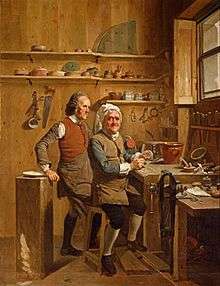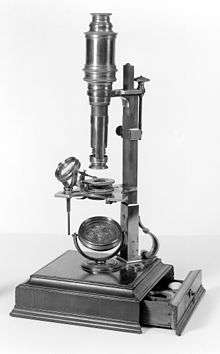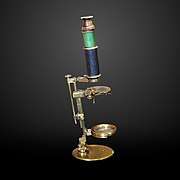John Cuff (optician)

John Cuff (c. 1708 – c. 1772) was an important English scientific instrument maker, particularly of microscopes.[2][3]
He was apprenticed to the optical instrument maker James Mann.[4] Cuff eventually set up his own establishment as a "SPECTACLE and MICROSCOPE Maker, At the sign of the Reflecting MICROSCOPE and SPECTACLES opposite Serjeant's Inn"[5] "(1737-57) & Double Microscope, three Pairs of Golden Spectacles & Hadley's Quadrant opposite Salisbury Court (1757-8) both in Fleet St & Strand, all in London, England."[4] In 1743, he advertised that he made and sold "Wholesale and Retale, all Manner of curious Optical INSTRUMENTS".[5]
Cuff failed to gain membership in the Royal Society,[6] but at a Society meeting in the winter of 1738-1739, he encountered Johann Nathanael Lieberkühn, a German physician who was promoting two microscopes of his own invention.[7] Cuff soon made improvements to the designs.[7] In 1745, the Swiss naturalist Abraham Trembley visited London and asked him to design a microscope that would make it easier to observe aquatic creatures as they were moving about.[7] Two years later, Cuff produced the "AQUATIC MICROSCOPE", "invented by him for the Examination of Water Animals."[7]
The naturalist Henry Baker complained to him about the shortcomings of Baker's Culpeper-type microscope: "Pulling the body of the Instrument up and down was likewise subject to Jerks, which caused a Difficulty in fixing it exactly at the Focus: there was also no good Contrivance for viewing opake Objects".[6] Under Baker's direction, Cuff designed and produced an improved "Double Microscope" that quickly supplanted the Culpeper type and became much sought-after not only in England, but all over Europe.[6][8] While superior to other microscopes of the time, optically it was no improvement,[9] and like them it still "suffered from severe chromatic and spherical aberration."[10]
Unfortunately, Cuff was apparently not much of a businessman: despite Baker's support, he had to declare bankruptcy in 1750.[6] In 1757, a Benjamin Martin opened a competing shop next door to Cuff's establishment on Fleet Street and drove him out of business the following year.[6][8]
According to the Royal Collection Trust, the German painter Johan Zoffany was commissioned by King George III, a purchaser of Cuff's microscopes, to depict him.[1] However, doubts have been expressed whether the painting titled John Cuff actually is a portrayal of him, and it has also been known as The Lapidaries or Two Old Men.[2]


Museum holdings
Cuff's instruments are found in several major collections of scientific instruments, including:
- Science Museum, London, England: 61 objects[4]
- Whipple Museum of the History of Science, Cambridge, England: five microscopes[6]
- Museo Galileo, Florence, Italy: two microscopes[3]
- Golub Collection, University of California, Berkeley, United States: one compound microscope[8]
- National Museum of American History, Washington D.C., United States: a 1752 aquatic microscope [7]
- Musée d'histoire des sciences de la Ville de Genève, Geneva, Switzerland: an aquatic microscope.
References
- 1 2 "John Cuff". Royal Collection Trust. Retrieved 27 February 2017.
- 1 2 "Cuff, John (1708?–1772?)". Oxford Dictionary of National Biography (online ed.). Oxford University Press. doi:10.1093/ref:odnb/48225. (Subscription or UK public library membership required.)
- 1 2 "John Cuff". Virtual Museum. Museo Galileo. Retrieved 27 February 2017.
- 1 2 3 "Cuff, John". Collections Online - People. Science Museum Group. Retrieved 27 February 2017.
- 1 2 "Advertisement for John Cuff, spectacle and microscope maker, 1743". Science & Society Picture Library.
- 1 2 3 4 5 6 Jardine, Boris. "John Cuff and the 'new-constructed' microscope". Explore Whipple Collections. Whipple Museum of the History of Science. Retrieved 27 February 2017.
- 1 2 3 4 5 Warner, Deborah. "The oldest microscope in the museum". Smithsonian: National Museum of American History. Retrieved 27 February 2017.
- 1 2 3 "John Cuff Compound Microscope". The Golub Collection. University of California at Berkeley. Retrieved 27 February 2017.
- ↑ Bradbury, S. (22 October 2013). The Microscope Past and Present: Pergamon International Popular Science Series. Elsevier. p. 93. ISBN 9781483138978.
- ↑ Michael W. Davidson. "John Cuff's Microscope". Museum of Microscopy, Florida State University.
| Wikimedia Commons has media related to John Cuff. |